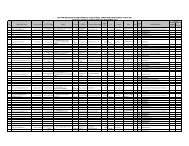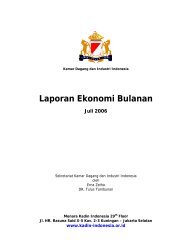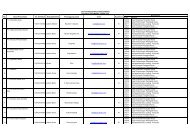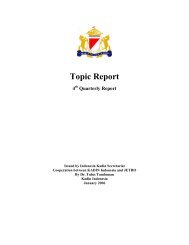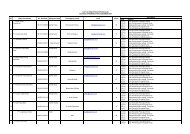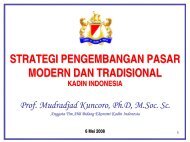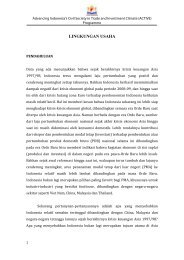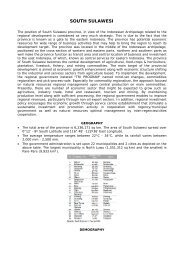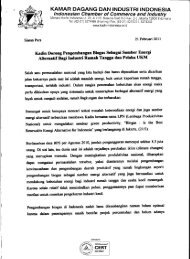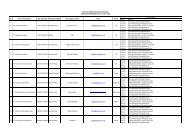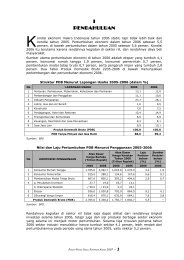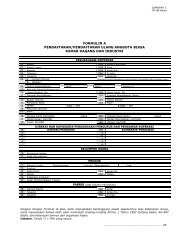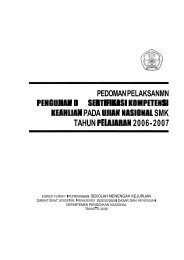Global Economic Outlook and Strategy - Kadin Indonesia
Global Economic Outlook and Strategy - Kadin Indonesia
Global Economic Outlook and Strategy - Kadin Indonesia
You also want an ePaper? Increase the reach of your titles
YUMPU automatically turns print PDFs into web optimized ePapers that Google loves.
February 28, 2008<br />
<strong>Global</strong> <strong>Economic</strong> <strong>Outlook</strong> <strong>and</strong> <strong>Strategy</strong><br />
country (<strong>and</strong> PDVSA’s) ability to meet debt service payments comfortably. However, the<br />
high dependence on oil sales to the United States means that threats of retaliation in the<br />
wake of the ExxonMobil case are unlikely to be carried out.<br />
Asia<br />
India. We expect growth to moderate from 8.7% in fiscal year 2008 to 8.3% in fiscal year<br />
2009, amid a deteriorating global economic environment coupled with continuing higher<br />
domestic interest rates. Growth would have been slower had it not been for positive<br />
structural changes <strong>and</strong> the uptrend in savings <strong>and</strong> investment. With 2008 being a preelection<br />
year, we expect renewed focus on infrastructure, health, education, <strong>and</strong><br />
agriculture/rural development.<br />
In January, the central bank kept all rates unchanged <strong>and</strong> said that risks to inflation have<br />
dem<strong>and</strong>ed priority over growth. After keeping domestic fuel prices on hold since it cut<br />
them in February 2007, when oil prices were US$58 per barrel, the government raised<br />
transport fuel prices by 4%. As this price hike is far lower than what is necessary to meet<br />
import costs, the government has increased the quantity of oil bonds, an off-balance sheet<br />
fiscal item, to compensate domestic oil companies. If all the off-balance sheet items are<br />
included in the budget arithmetic, the headline deficit would rise by roughly 120 basis<br />
points. Against this backdrop, we expect the pace of rupee appreciation to be limited to 5%<br />
<strong>and</strong> thus maintain our yearend target of R37/US$.<br />
Philippines. Fundamentals remain solid, even as the global economy slows down. Fourth<br />
quarter GDP grew by 7.3% year to year. The downside risk from potential export<br />
weakness, investor risk aversion, <strong>and</strong> heightened political risk premia relating to the latest<br />
corruption allegations are likely to weaken the upbeat momentum. In late January, shortterm<br />
bank rates spiked to the low double-digit range, well above the policy rate of 5%.<br />
Special deposit accounts increased as liquidity sought safer outlets. If credit <strong>and</strong> monetary<br />
conditions continue to tighten without a corresponding policy rate response, interest rate<br />
volatility could be negative for consumer <strong>and</strong> business sentiment.<br />
A possible stall of infrastructure spending remains the major threat to domestic dem<strong>and</strong><br />
this year. Persistent financial market tightening could also aggravate downside risks. This<br />
worst-case scenario could transpire if tax collection efficiency fails to improve the<br />
government’s cash flow. The deficit may balloon in the first half of 2008 if the bulk of the<br />
PHP200 billion infrastructure program is front-loaded as a fiscal hedge against offshore<br />
downside influences. We expect peso appreciation to the 37.50 range against the USD in<br />
the second half. Easing inflation risk in the second quarter, a strong peso, <strong>and</strong> a less robust<br />
cyclical environment set the stage for a policy rate cut of another 50 basis points later this<br />
year.<br />
Singapore. The fairy-tale combination of strong growth <strong>and</strong> low inflation has come to an<br />
end. Fourth-quarter real GDP grew 5.4%, below market expectations of 6%. The<br />
government has revised down its 2008 GDP growth forecast range to 4%-6% from 4.5%-<br />
6.5%. Our GDP forecast for 2008 st<strong>and</strong>s at 5.6%, taking into account a manufacturing<br />
contraction in the first half. But further downgrades closer to 4% are possible if the U.S.<br />
recession proves deeper or longer than we currently foresee.<br />
Despite a slowdown in potential growth, we expect inflation to accelerate to 5% from 2.2%<br />
in 2007. The combined impact of fuel <strong>and</strong> food price increases, hikes in electricity tariffs,<br />
<strong>and</strong> a 20% upward revision in imputed rents to public housing (HDB annual values) in<br />
January may push inflation through 6% in the first half, before moderating to around 4% in<br />
35




